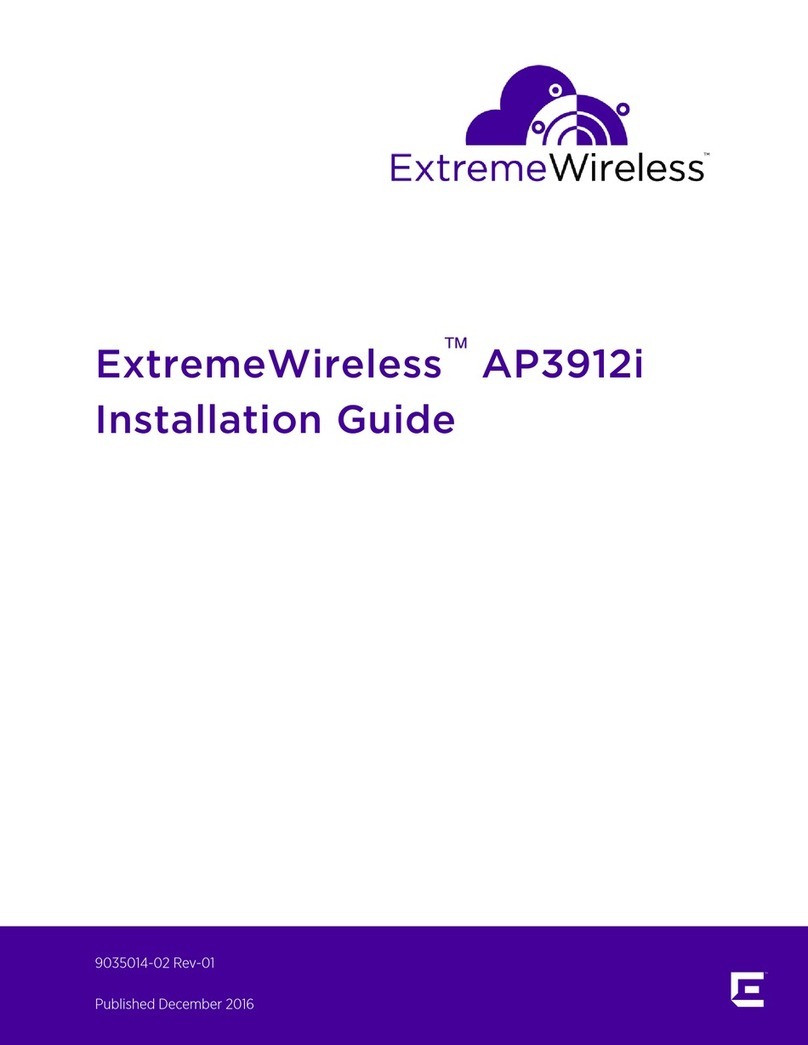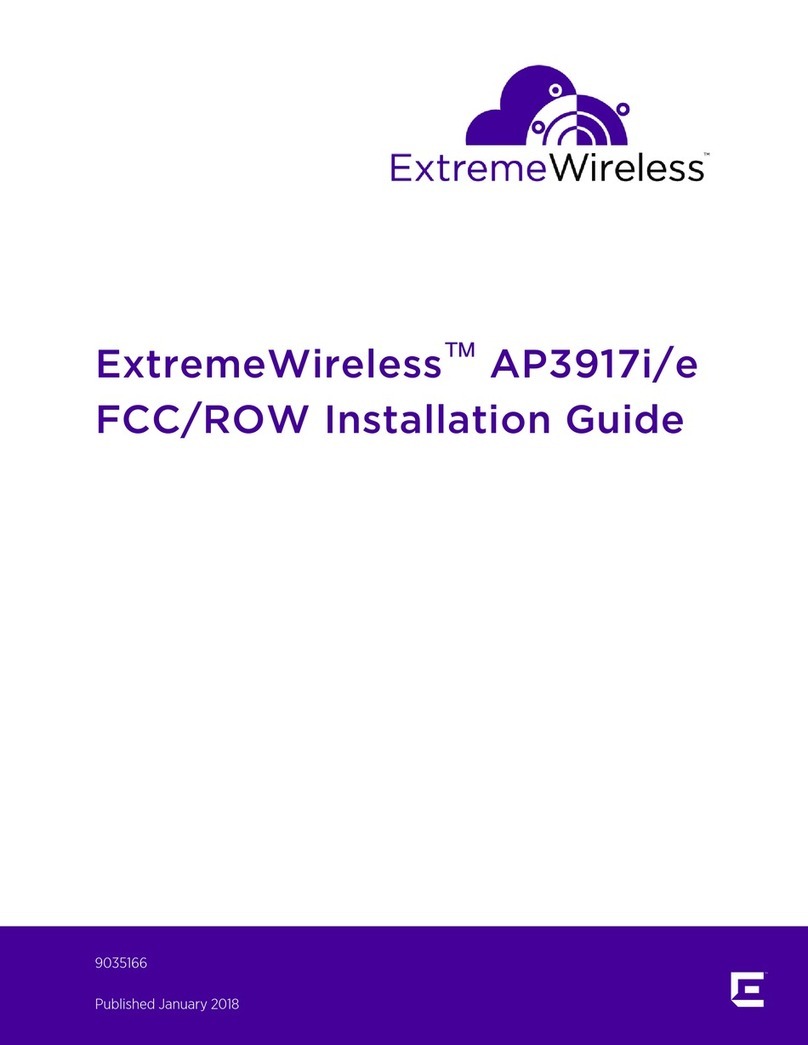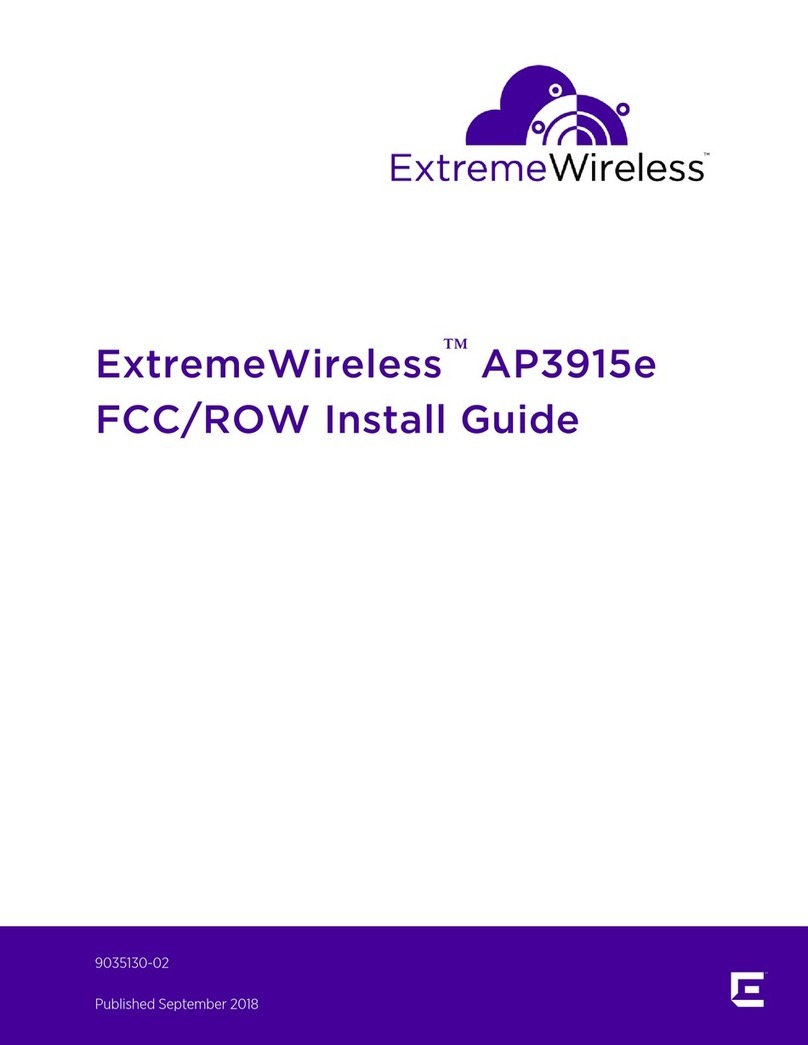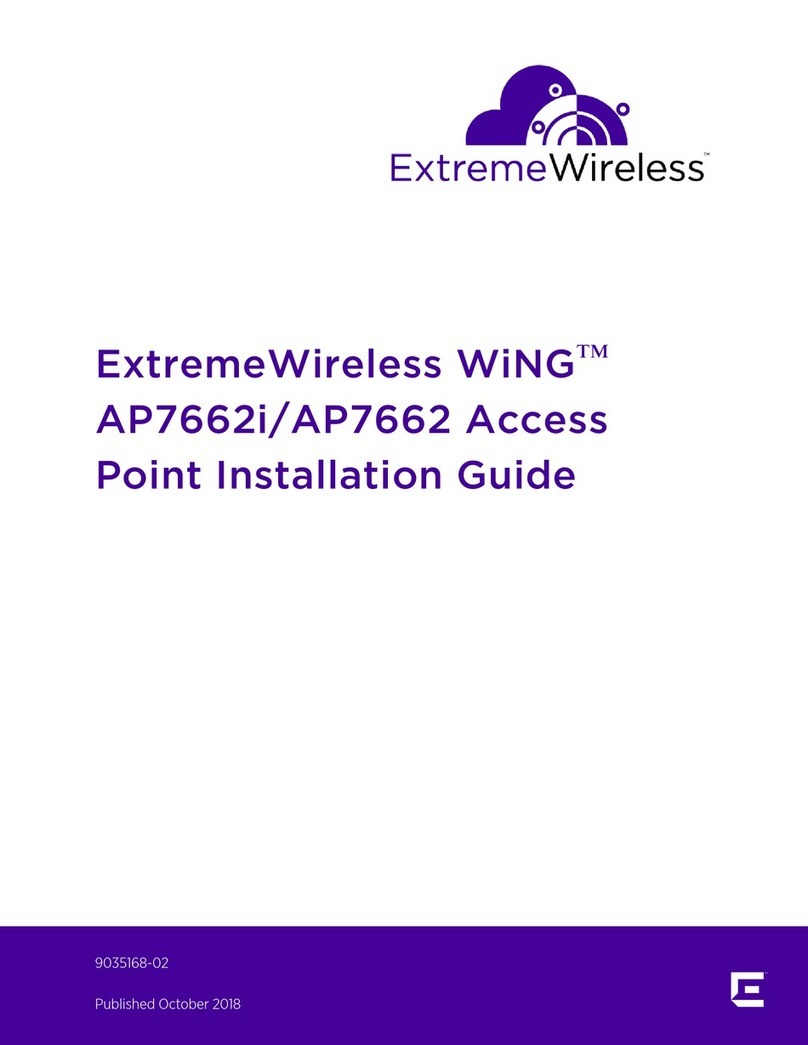Installing the ExtremeWireless Indoor
AP3912i Access Point
Overview of the AP3912i
The AP3912i is a wall plate 11ac Wave 2 AP that lets you
extend your Wireless LAN and deploy local Wifi while still
providing extension for wired clients from the same
Ethernet jack. This fully-featured access point plugs into
existing Ethernet cabled wall plates. The AP provides
application visibility and control and policy support over
three radios and three wired LAN ports. Wireless and wired
traffic can be assigned application-level policy right at the
access point. The AP3912i provides flow based data
handling for the wireless and wired connections in a single
plug and play package. There is minimal or no impact to the
existing infrastructure. The pass-through port can be used
to directly expose an additional switch port from the same
jack. The PSE port provides PoE (802.3af) which allows to
directly power devices such as IP Phones and IP cameras.
The AP3912i is designed with four single-band internal
antennas for indoor use only.
The AP3912i model has the following specifications:
• Primarily designed to support wall, single and dual-gang
box installation.
• Radios: Two concurrent WiFi radios (2.4 GHz and 5 GHz)
and one additional radio that can operate as Bluetooth or
802.15.4.
•LEDs:6(Figure 2)
• Power: 802.3at (PoE+) compliant for full functionality.
802.3af is supported with reduced functionality.
• The AP3912i supports the 802.11ac and 802.11n wireless
standards, with full backward compatibility with legacy
802.11abg.
• The AP3912i interoperates fully with Wireless LAN,
including support for VoWLAN, branch office mode,
guest services, RTLS, availability, and mobility.
• Enabled for ExtremeCloud support.
For detailed installation information about the AP3912i, see
the ExtremeWireless AP3912i Installation Guide.
Uplink and Power Connections
The AP3912i uses Power over Ethernet (PoE) as follows:
The AP has three client ports (P1. P2 and P3/PSE). These
client ports let users connect wired clients, such as laptops
and printers, to the network. The PSE power on P3 is
enabled only if LAN 1 is powered using 802.3at.
When the PSE is enabled, 802.3af PoE devices, such as IP
cameras, can be powered from P3.
The pass-through port (blue connector) in Figure 1 and
Figure 4 allow direct connection to a second switch port.
Note: The AP3912i requires a minimum base firmware of
10.21.01.
Table 1 Power Sources
Power Source Description
LAN 1 - uplink PoE
port
LAN 1 may be connected using an
802.3at or 802.3af switch port
PoE 802.3at Power is enabled on the PSE Client port
and the PSE LED is green.
PoE 802.3af Power is disabled on the PSE Client port
and the LED is off (not green).
The Reset button (Figure 1) is to the right of the power
connections.
Figure 1 Power Connections and Reset Button
LEDs
LEDs are located on one side of the AP.
Figure 2 LEDs on Side of AP
Verifying the AP3912i Box Contents
Verify the contents of the box as listed in the following
table:
Mounting and Connecting the AP3912i
Use these instructions as guidelines for mounting and
connecting the AP3912i easily and safely.
Attach the AP3912i to an indoor wall or junction/gang box.
The wall plate bracket is included with the AP box contents.
Note: LAN connectors with shrouds will not fit into the
ports. Remove the shroud or use an optional jumper cable.
Status Radio 2 (2.4 GHz)
LAN 1 (Ethernet 1) PSE Client Port
Radio 1 (5 GHz) IoT (BLE or 802.15.4)
Table 2 Contents of the AP3912i Box
Quantity Item
1AP3912iQuickReference
1 ExtremeCloud Quick Start Card
1 WS-AP3912i AP
1 Wall plate bracket (includes Security Torx captive
screw)
The following hardware is included:
2 Screw-in wall anchors
2 Pan-head machine screws
2 Flat-head wood screws
1 Security Torx key (size T10)
Note: Before mounting the AP3912i, read the Safety
Guidelines section.
The AP mounting bracket is designed for single and dual-
gang box configurations. For wider installations, you can
either adapt the existing bracket or opt to wall-mount the
AP.
You also have the option to additionally purchase the WS-
MBI-WALL05 bracket (#30521). The WALL05 bracket is
designed for wall, junction/gang box, and table
configurations. The WS-MBI-WALL05 bracket can be used:
• Without a hole in the wall.
• On a table.
• To physically secure the LAN cable when AP3912i is
installed on a wall without a hole.
For information about WALL05 bracket configuration, see
the ExtremeWireless AP3912i Installation Guide.
Figure 3 Mounting Bracket
Mounting the AP3912i to a Wall
1 Using the mounting bracket (Figure 3) as a guide,
choose a location where it is feasible to place the AP’s
center. The location must allow the LAN cables to come
out of the wall within the large rectangular hole. Place
the bracket against the wall. (The captive screw will be
used to lock the AP in place.) Decide which two holes to
use to mount the bracket. We recommend that the two
holes be on opposite sides of the large center opening.
2 Mark the two hole centers.
3 For drywall/plasterboard walls, drill two holes using a
drill bit of 1/4” or 6mm diameter.
4 For drywall/plasterboard walls, screw the plastic anchors
into the holes.
5 Attach the wall plate bracket using the two wood screws.
Torque the screw to 7.0 in-lbs.
6 Connect the LAN cable from the wall and attach the AP
to the mounting bracket, as described below.
Mounting to a Junction/Gang Box
1 Place the bracket over the junction box with the captive
screw on the left side (Figure 3) and the large, flat plate
against the wall. The bracket should be attached to a
vertical surface.
Tab le 3
Number Description
1 AP mounting tabs
2 Security Torx captive screw
2 Align two of the bracket holes with two of the box’s
holes. Use bracket holes that are closest to the center of
the bracket. Make sure that the entire box is covered by
the bracket.
3 Using the two pan head machine screws, attach the
bracket to the box using the aligned holes. Torque the
screws to 9.0 in-lbs.
4 Connect the power through the bracket to the AP, and
attach the AP to the mounting bracket, as described
below.
Figure 4 Back View
Connecting the AP to the Network
Connect the building LAN 1 wire (either PoE+ at or PoE af)
to the black RJ-45 connector using short patch cables.
Alternatively, connect using the associated punch-down
block. The connector and punch-down block are located on
the rear of the AP.
Additionally, you can connect the pass-through cable to the
blue connector (top) on the back of the AP.
If you are using the punch-down block, use a punch down
tool with a 110 blade. For information about pin colors, see
the ExtremeWireless AP3912i Installation Guide.
Mounting the AP to the Bracket
1 Line up the AP holes (see the arrows in Figure 4) on the
rear with the two "L" shaped angled tabs near the right
side of the bracket (Figure 3, item #1).
2 Insert the “L” tabs into the holes and rotate the AP until it
is parallel to the back of the attachment surface.
3 Slide the AP approximately 1/4” to the left on the two
bracket tabs.
4 Attach and tighten the security torx screw (Figure 3) to
the AP so that the AP is attached to the bracket. Torque
the screw to 7.0 in-lbs.
Caution: Make sure that the wires are punched down professionally.
Otherwise the LAN 1 link speed will be dropped to 100 Mbps,
instead of 1000 Mbps.





























